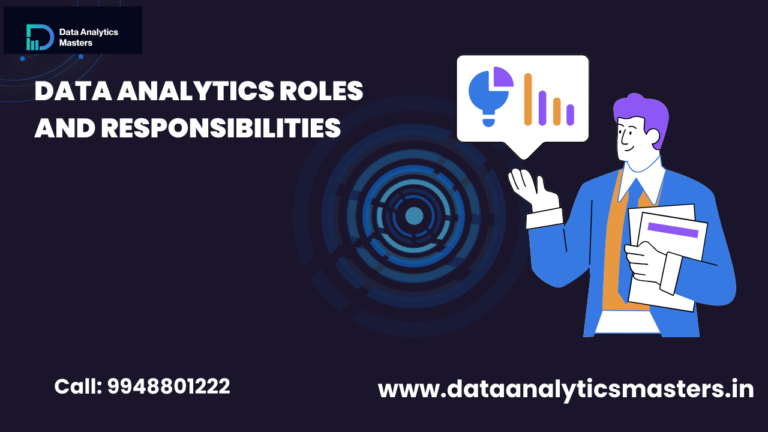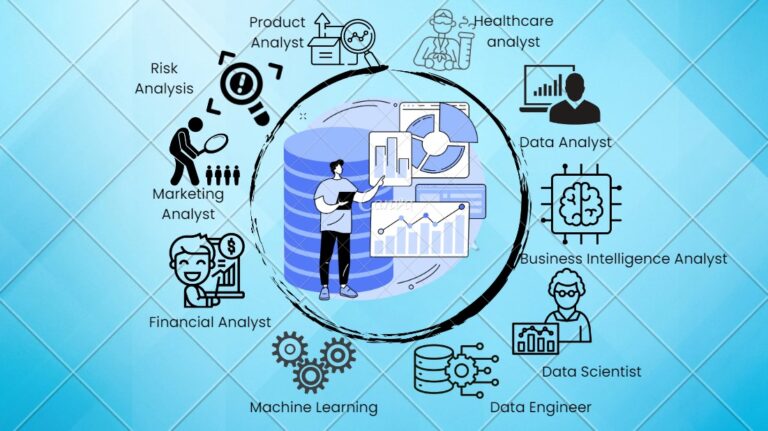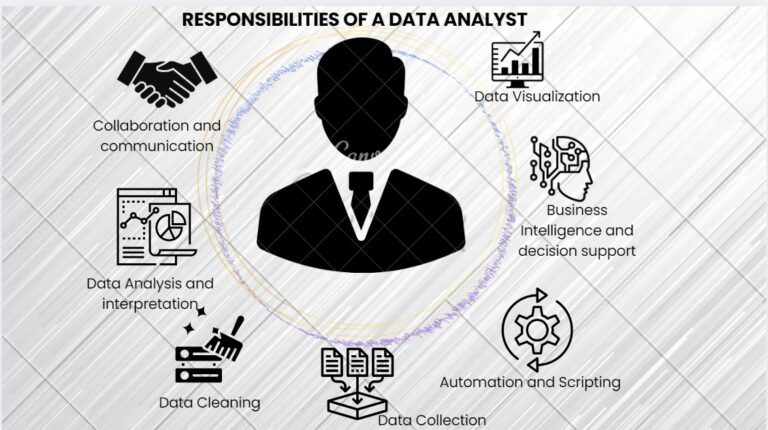Data Analytics Roles and Responsibilities in Modern Way

Data analytics roles and responsibilities involve collecting, processing, and analyzing data to drive business decisions. Data Analysts extract insights from raw data, while BI Analysts create dashboards for visualization. Data Scientists build predictive models using machine learning, and Data Engineers design data pipelines for efficient processing. Machine Learning Engineers develop AI-powered solutions, while Marketing Analysts track customer behavior. Other roles, such as Risk Analysts, Financial Analysts, Product Analysts, and Healthcare Data Analysts, specialize in data-driven decision-making. Strong skills in SQL, Python, and data visualization tools are essential to succeed in the field of data analytics.
1. Data Analyst :
- Collects, cleans, and analyzes data to find trends and insights.
- Uses tools like SQL, Python, Excel, and Tableau/Power BI for reporting.
Responsibilities:
- Collect, clean, and analyze large datasets to identify trends.
- Develop reports and dashboards to present insights.
- Use SQL to retrieve and manage data from databases.
- Work with tools like Excel, Tableau, and Power BI for data visualization.
- Support business teams with data-driven recommendations.
Example: A data analyst at an e-commerce company might study customer purchase patterns to suggest better product recommendations.
Duties:
- Gather, clean, and analyze data from multiple sources.
- Identify patterns and trends to support business decisions.
- Develop reports and dashboards using Power BI, Tableau, and Excel.
- Write SQL queries to extract relevant data from databases.
- Present insights to stakeholders in a clear and actionable format.
These Data Analytics Roles and Responsibilities help organizations make informed decisions and optimize performance.
Salary Overview:
- Entry-Level: ₹4-6 LPA
- Mid-Level (2-3 years): ₹7-9 LPA
- Senior-Level (5+ years): ₹12-13 LPA
- Insight: Salaries can vary based on the industry. For example, data analysts in the banking sector with three years of experience can earn ₹20 LPA or more.
Real-Life Success Stories:
Data Analyst – Shifting from Finance to Analytics
Name: Priya Sharma
Background: Former Accountant
Journey: Priya had a strong grasp of numbers but wanted to shift toward data-driven decision-making. She completed an online data analytics course, mastering SQL, Power BI, and Excel. She then built a portfolio focused on financial data analysis, which helped her secure a data analyst role.
Current Role: Works as a data analyst at a fintech company, optimizing loan approval processes.
Lesson Learned: Transitioning from finance to data analytics is achievable with the right skills and hands-on projects.
2. Business Intelligence (BI) Analyst :
- Focuses on turning data into business insights for decision-making.
- Works with BI tools like Power BI, Tableau, Looker to create dashboards.
Responsibilities:
- Create and manage interactive dashboards for business reporting.
- Analyze key performance indicators (KPIs) to assess company performance.
- Use SQL, Power BI, and Tableau for data processing and visualization.
- Work with teams to enhance business operations through data insights.
- Ensure data accuracy and reliability in reports.
Duties:
- Design and maintain dashboards for tracking business performance.
- Analyze structured and unstructured data to provide insights.
- Collaborate with teams to define key performance indicators (KPIs).
- Use business intelligence tools like Tableau and Power BI.
- Ensure data accuracy and consistency across different departments.
Example: A BI analyst at a retail company may track sales performance across different store locations.
Salary Overview:
- Entry-Level: ₹6-8 LPA
- Mid-Level: ₹8-12 LPA
- Senior-Level: ₹12-15 LPA
Real-Life Success Stories:
Business Intelligence (BI) Analyst – From Engineering to BI
Name: Rajeev Menon
Background: Mechanical Engineer
Journey: Rajeev worked in supply chain management and noticed inefficiencies in logistics. He started using Power BI to analyze data and later took a course on data visualization and SQL. His newfound skills enabled him to shift into a BI analyst role, showcasing key Data Analytics Roles and Responsibilities such as data analysis, reporting, and decision-making support.
Current Role: BI Analyst at a logistics company, helping streamline inventory and delivery processes.
Lesson Learned: Learning business intelligence tools and SQL can help professionals transition into BI roles, even from non-tech backgrounds.
3. Data Scientist :
- Uses machine learning, AI, and statistical modeling to build predictive models.
- Works with Python, R, TensorFlow, and Scikit-learn for advanced analytics.
Responsibilities:
- Apply machine learning techniques to analyze and predict business trends.
- Conduct statistical analysis to solve complex problems.
- Use Python, R, TensorFlow, and Scikit-learn for data modeling.
- Develop and deploy predictive analytics models.
- Communicate data findings effectively to decision-makers.
Duties:
- Develop machine learning models to solve business problems.
- Use programming languages like Python and R for data analysis.
- Work with big data tools such as Hadoop and Spark.
- Build predictive models for areas like customer behavior and fraud detection.
- Present findings in a way that decision-makers can understand.
Example: A data scientist at a streaming platform might create an algorithm to recommend movies based on viewing history.
Salary Overview:
- Entry-Level: ₹8-10 LPA
- Mid-Level: ₹10-15 LPA
- Senior-Level: ₹15-20 LPA
Real-Life Success Stories:
Data Scientist – Self-Taught to Expert
Name: Arjun Patel
Background: IT Support Engineer
Journey: Arjun was fascinated by machine learning and began self-learning through online courses and Kaggle competitions. He developed projects on predictive analytics and shared them on GitHub, which caught the attention of recruiters.
Current Role: Data Scientist at an e-commerce company, forecasting customer purchasing trends.
Lesson Learned: A strong portfolio and practical knowledge can outweigh the need for a formal data science degree.
4. Data Engineer:
- Builds and maintains data pipelines, databases, and ETL processes.
- Works with SQL, Apache Spark, Hadoop, and cloud platforms (AWS, Azure, GCP).
Responsibilities:
- Design and develop data pipelines and ETL (Extract, Transform, Load) processes.
- Manage and optimize databases and cloud storage systems.
- Work with SQL, Apache Spark, Hadoop, AWS, and Google Cloud.
- Ensure data security, consistency, and scalability.
- Automate workflows to improve data processing efficiency.
Duties:
- Develop and maintain data pipelines for processing large datasets.
- Optimize database performance using SQL and NoSQL solutions.
- Create and manage ETL (Extract, Transform, Load) workflows.
- Ensure data security and reliability.
- Use cloud platforms like AWS, Azure, or Google Cloud to store and process data.
Example: A data engineer at a financial institution may build systems to process transactions securely.
Salary Overview:
- Entry-Level: ₹8-10 LPA
- Mid-Level: ₹10-15 LPA
- Senior-Level: ₹15-20 LPA
Real-Life Success Stories:
Data Engineer – Advancing from SQL to Big Data
Name: Sneha Reddy
Background: SQL Database Developer
Journey: With a background in database management, Sneha wanted to expand into big data engineering. She studied Apache Spark, Hadoop, and cloud computing (AWS, GCP) and earned a certification in data engineering, which led to her career shift.
Current Role: Data Engineer at a healthcare technology company, handling large-scale patient data.
Lesson Learned: SQL expertise provides a strong foundation for transitioning into data engineering.

5. Machine Learning Engineer :
- Develops and deploys AI and ML models for automation and predictions.
- Uses Python, TensorFlow, PyTorch, and cloud AI services.
Responsibilities:
- Build and deploy machine learning models and AI-based applications.
- Improve model accuracy and performance through optimization techniques.
- Work with frameworks like TensorFlow and PyTorch.
- Integrate machine learning models into business software.
- Monitor model performance and update algorithms with new data.
Duties:
- Develop and train machine learning models for automation.
- Use frameworks like TensorFlow and PyTorch to build AI applications.
- Optimize model performance for real-time decision-making.
- Integrate AI models into business software and applications.
- Continuously improve models based on new data.
Salary Overview:
- Entry-Level: ₹8-10 LPA
- Mid-Level: ₹10-15 LPA
- Senior-Level: ₹15-20 LPA
Real Life Success Stories:
Machine Learning Engineer – From Research to AI Development
Name: Vikram Desai
Background: Ph.D. in Mathematics
Journey: Despite an academic background, Vikram lacked industry exposure. He built machine learning models for fraud detection and shared them on open-source platforms. His work attracted recruiters, leading to his first job in AI.
Current Role: Machine Learning Engineer at a cybersecurity firm, enhancing fraud detection models.
Lesson Learned: Contributing to open-source projects can help bridge the gap between research and industry roles.
6. Marketing Analyst :
- Analyzes customer data, campaign performance, and market trends.
- Uses Google Analytics, SQL, and Excel for marketing insights.
Responsibilities:
- Study customer behavior, sales trends, and marketing campaign results.
- Use Google Analytics, SQL, and Excel to analyze marketing data.
- Measure the return on investment (ROI) of marketing efforts.
- Conduct A/B testing to improve marketing strategies.
- Provide data-based recommendations for better audience targeting.
Duties:
- Analyze data from marketing campaigns to measure effectiveness.
- Use tools like Google Analytics and SQL to track customer behavior.
- Conduct A/B testing to improve advertising strategies.
- Measure return on investment (ROI) for digital marketing efforts.
- Identify target audiences for personalized promotions.
Example: A marketing analyst at an online advertising company might study user engagement to improve ad targeting.
Salary Overview:
- Entry-Level: ₹4-6 LPA
- Mid-Level: ₹6-8 LPA
- Senior-Level: ₹8-12 LPA
Real Life Success Stories:
Marketing Analyst – From Creativity to Data-Driven Insights
Name: Pooja Verma
Background: Social Media Manager
Journey: Pooja realized that understanding data was crucial for optimizing digital campaigns. She learned Google Analytics, SQL, and A/B testing techniques. Her ability to analyze marketing performance led to a promotion.
Current Role: Marketing Analyst at a digital marketing agency, optimizing ad strategies.
Lesson Learned: Digital marketers with analytical skills can transition into data-driven roles.
7. Financial Analyst (Data-Driven) :
- Uses data analytics to assess financial risks, investment opportunities, and forecasts.
- Works with Excel, SQL, Python, and Power BI for financial modeling.
Responsibilities:
- Analyze financial data to predict revenue and investment risks.
- Use Excel, SQL, Power BI, and Python for financial modeling.
- Identify opportunities to reduce costs and improve business growth.
- Conduct financial risk assessments and prepare reports.
- Monitor economic trends and assess their impact on company finances.
Duties:
- Analyze financial data to forecast revenue and expenses.
- Work with tools like Excel, Power BI, and SQL for financial modeling.
- Evaluate investment opportunities and risks.
- Prepare financial reports for management.
- Monitor market trends to provide financial insights.
Example: A financial analyst at a bank might assess the impact of interest rate changes on loan profitability.
Salary Overview:
- Entry-Level: ₹5-7 LPA
- Mid-Level: ₹7-10 LPA
- Senior-Level: ₹10-15 LPA
Real Life Success Stories:
Financial Analyst – Upgrading from Excel to Advanced Analytics
Name: Akash Mehta
Background: Accountant
Journey: Akash worked extensively with Excel but saw the potential of automation. He learned Power BI, SQL, and Python, enabling him to create financial models that improved reporting efficiency. This impressed his leadership team and secured him a financial analytics role.
Current Role: Financial Analyst at an investment firm, conducting financial risk analysis.
Lesson Learned: Mastering automation and data visualization tools can elevate financial professionals into analytics roles.
8. Risk Analyst :
- Identifies potential risks in business operations and finances.
- Uses predictive analytics and statistical models for risk assessment.
Responsibilities:
- Identify and assess financial, operational, and cybersecurity risks.
- Use predictive modeling and statistical analysis to minimize risks.
- Work with SQL, Python, and R for risk evaluation.
- Monitor fraud detection systems and ensure regulatory compliance.
- Develop risk management reports and strategies for decision-makers..
Duties:
- Identify financial, operational, and security risks in a company.
- Develop models to predict potential risks and fraud.
- Use statistical analysis tools like Python and R.
- Ensure compliance with regulatory requirements.
- Provide reports on risk mitigation strategies.
Example: A risk analyst at an insurance company may analyze past claims to detect fraud patterns.
Salary Overview:
- Entry-Level: ₹5-7 LPA
- Mid-Level: ₹7-10 LPA
- Senior-Level: ₹10-15 LPA
Real Life Success Stories:
Risk Analyst – Growing Within the Banking Sector
Name: Swati Nair
Background: Compliance Officer
Journey: Swati wanted to transition into risk analytics. She took an advanced analytics course, learned Python and R, and collaborated with fraud detection teams. Her work significantly contributed to reducing financial risks.
Current Role: Risk Analyst at a global bank, identifying and preventing fraudulent activities.
Lesson Learned: Developing analytical skills can unlock new career opportunities in risk management.
9. Product Analyst :
- Analyzes user behavior and product performance to optimize features.
- Works with A/B testing, SQL, and product analytics tools (Google Analytics, Mixpanel).
Responsibilities:
- Analyze user behavior to enhance product features and overall experience.
- Use SQL, Google Analytics, and Mixpanel for product data analysis.
- Conduct A/B testing to evaluate the effectiveness of product changes.
- Collaborate with UX/UI teams to improve product usability.
- Track product performance metrics and make data-driven recommendations.
Duties:
- Analyze customer usage data to improve product features.
- Conduct A/B testing to test new product changes.
- Work with SQL, Google Analytics, and other analytics tools.
- Provide data-driven recommendations for product improvements.
- Collaborate with UX teams to enhance user experience.
Example: A product analyst at a mobile app company might study user behavior to suggest feature improvements.
Salary Overview:
- Entry-Level: ₹6-8 LPA
- Mid-Level: ₹8-12 LPA
- Senior-Level: ₹12-15 LPA
Real Life Success Stories:
Product Analyst – From Software Development to Data-Driven Product Decisions
Name: Kunal Tiwari
Background: Software Developer
Journey: Kunal was interested in understanding user behavior and how products evolve. He started analyzing user engagement data using SQL and Google Analytics, building insights that influenced product strategy. This helped him transition into a product analytics role.
Current Role: Product Analyst at a SaaS company, improving customer engagement.
Lesson Learned: Software developers can leverage data analytics to shift into product management and analytics roles

10. Healthcare Data Analyst :
- Works with healthcare data to improve patient outcomes and hospital efficiency.
- Uses SQL, Python, and Tableau to analyze medical records and trends.
Responsibilities:
- Analyze patient records and medical data to improve healthcare services.
- Use SQL, Python, Tableau, and electronic health record (EHR) systems.
- Identify patterns in disease trends and treatment outcomes.
- Ensure compliance with healthcare data regulations such as HIPAA.
- Assist hospitals in optimizing resources and reducing operational costs.
Duties:
- Analyze medical records and patient data to improve healthcare services.
- Use tools like SQL, Tableau, and Excel for healthcare analytics.
- Identify trends in diseases and medical treatments.
- Ensure compliance with healthcare data regulations.
- Help hospitals and clinics make data-driven decisions.
Example: A healthcare data analyst at a pharmaceutical company might analyze clinical trial data to measure the effectiveness of a new drug.
Salary Overview:
- Entry-Level: ₹5-7 LPA
- Mid-Level: ₹7-10 LPA
- Senior-Level: ₹10-15 LPA
Real Life Success Stories:
Healthcare Data Analyst – Using Data to Improve Patient Care
Name: Dr. Meera Joshi
Background: Public Health Researcher
Journey: Dr. Meera wanted to leverage data to improve healthcare services. She learned SQL, Tableau, and statistical analysis to assess patient treatment outcomes. Her insights led to optimized resource allocation and improved patient care.
Current Role: Healthcare Data Analyst at a government hospital, enhancing treatment strategies.
Lesson Learned: Data analytics can significantly impact healthcare, leading to better patient outcomes and resource efficiency.
Factors That Affect Salary
Several factors influence how much you can earn in a data analytics role:
- Experience – More experience typically leads to better pay.
- Location – Cities like Bengaluru and Mumbai tend to offer higher salaries due to demand and cost of living.
- Industry – Different industries, such as finance and healthcare, may have varying pay scales.
- Company Size – Larger companies and multinational corporations (MNCs) often provide higher salary packages.
Conclusion on Data Analytics Roles and Responsibilities
Data analytics professionals help businesses make smart decisions by turning raw data into useful insights. Each role—whether it’s a Data Analyst creating reports, a Data Scientist predicting trends, or a Data Engineer managing data systems—has its own importance. To succeed, professionals need strong technical skills, problem-solving abilities, and clear communication. As companies rely more on data, the expectations for these roles will grow, making continuous learning essential.


 in Hyderabad by Brolly.Group
in Hyderabad by Brolly.Group